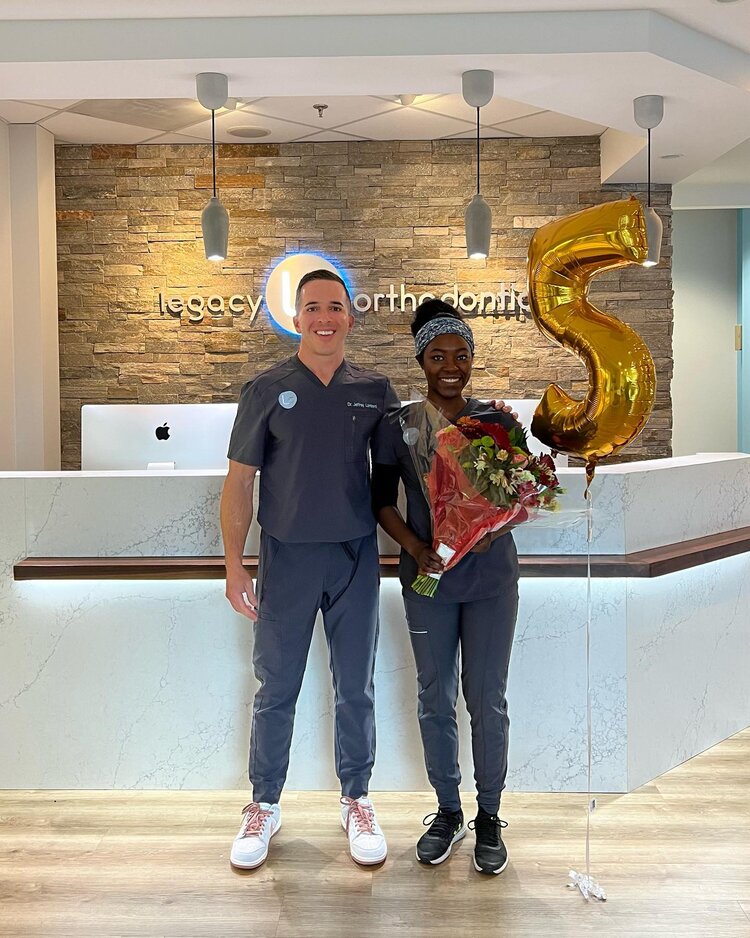Legacy Orthodontics for Dummies
Legacy Orthodontics for Dummies
Blog Article
Facts About Legacy Orthodontics Revealed
Table of ContentsAbout Legacy OrthodonticsTop Guidelines Of Legacy OrthodonticsThe Legacy Orthodontics StatementsLegacy Orthodontics Things To Know Before You Get ThisThe Definitive Guide to Legacy Orthodontics
At Advanced Orthodontics, we give people with a all natural treatment experience. On top of that, we provide flexible therapy schedules, adaptable repayment options and a fun, satisfying experience. leesburg braces. Phone call ( 480) 357-4900 today to find out more and schedule an appointment.An orthodontist is a dentist trained to identify, stop, and treat teeth and jaw abnormalities. They deal with existing conditions and are trained to determine problems that might develop in the future. Orthodontists collaborate with individuals of every ages, from children to grownups. Individuals commonly associate an ideal smile with healthiness.
Malocclusion, or misaligned teeth, can bring about dental issues, including dental caries, gum condition, and hard or unpleasant chewing. Not everyone is birthed with straight teeth. If you have a negative bite or huge rooms in between your teeth, you might want to consult a dentist focusing on orthodontic care.
10 Easy Facts About Legacy Orthodontics Described
( Image Credit Rating: DigitalVision/Getty Images) Orthodontists make use of taken care of and removable oral devices, like dental braces, retainers, and bands, to change the placement of teeth in your mouth. Orthodontic treatment is for dental problems, including: Uneven teethBite problems, like an overbite or an underbiteCrowded teeth or teeth that are too much apartJaw misalignmentThe objective of orthodontic treatment is to improve your bite.
While you could think of orthodontists as primarily for kids or teens that require braces, they can deal with dental troubles at any age. Orthodontists attend college, dental institution, and orthodontic college.
All orthodontists are dental professionals, but not all dental professionals are orthodontists. Orthodontic residency programs provide intensive, concentrated direction for oral experts. They concentrate on 2 locations: How to correctly and securely relocate teeth How to effectively direct advancement in the teeth, jaw, and faceOnce an orthodontist has completed training, they have the choice to come to be board certified.
Legacy Orthodontics - The Facts
Malocclusion leads to tooth congestion, an irregular jaw, or uneven bite patterns. Malocclusion is typically treated with: Your orthodontist attaches metal, ceramic, or plastic square bonds to your teeth.
If you have just minor malocclusion, you may be able to utilize clear braces, called aligners, as opposed to standard braces (https://www.sooperarticles.com/authors/788744/brian-mccune.html). Some individuals need a headwear to aid relocate teeth into line with pressure from outside the mouth. After dental braces or aligners, you'll need to put on a retainer. A retainer is a custom tool that keeps your teeth in area.
They're most often made use of on youngsters. They can develop added area in the mouth without needing to pull teeth. If you have a significant underbite or overbite, you could require orthognathic surgery (additionally called orthodontic surgical procedure) to lengthen or reduce your jaw. Orthodontists utilize wires, medical screws, or plates to sustain your jaw bone.
You might require to see an orthodontist if you have: Crowding or not adequate room for all of your teethOverbite, when your upper check here teeth come over your base teethUnderbite, when your base teeth are too far forwardSpacing or problems with gapsCrossbite, which is when your upper teeth fit behind your base teeth when your mouth is closedOpen bite or an upright gap between your front bottom and top teethMisplaced midline, when the center of your bottom and top teeth do not line up Remedying a dental malocclusion can: Make biting, eating, and speaking easierImprove the proportion of our face and your general appearanceEase pain from temporomandibular joint problemsSeparate your teeth and make them less complicated to cleanse, aiding stop dental cavity or cavities It's typically a dental practitioner who initially notifications misaligned teeth throughout a routine examination.
Legacy Orthodontics Fundamentals Explained

Throughout your initial orthodontic appointment, you'll likely have: An oral examPhotos taken of your face and smileDental X-raysPanoramic (360 degree) X-rays of your face and headImpressions to create molds of your teethThese examinations will certainly aid your orthodontist recognize just how to continue with your treatment. invisalign. An orthodontist is a dentist who's had training to treat your teeth and jaw
Orthodontists might perform surgery, exams,X-rays,and more to help you achieve an extra comfortable, healthier smile. An orthodontist is concentrated on your bite, so something like a damaged tooth would be managed by a dental practitioner. Orthodontists are dental practitioners yet not all dental practitioners are orthodontists. Orthodontists are concentrated on your bite, or the method your teeth fit together, and the straightness of your teeth.
Ever before questioned just how celebs constantly seem to have completely aligned teeth? Orthodontists are oral experts that concentrate on remedying abnormalities in the teeth and jaws.
Legacy Orthodontics for Beginners

, orthodontists have a diverse toolkit at their disposal. These tried-and-true dental braces make use of a system of braces adhered to the teeth and linked by wires.
Clear aligners, like Invisalign, are a popular choice for people looking for an extra discreet treatment option. These detachable trays are customized to gradually shift the teeth's setting. Headgear may be made use of together with dental braces or aligners to apply added targeted pressures, particularly for remedying jaw discrepancies. In situations of slim jaws, palatal expanders can be used to create space for correct tooth positioning.
Report this page